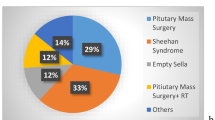Abstract
Purpose. The study determined the pharmacokinetics of urinary human follicle stimulating hormone (u-hFSH) in 12 down-regulated healthy female volunteers.
Methods. Following pituitary desensitization, baseline FSH serum levels were measured over a 24-hour period. Then each subject received, in random order, single doses of u-hFSH (Metrodin®), 75 IU, 150 IU and 300 IU iv, and 150 IU im on four occasions separated by washout periods of one week. Blood and urine samples were collected at preset times. FSH levels were measured by a immuno-radiometric assay and an in vitro rat granulosa cells aromatase bioassay.
Results. All doses of u-hFSH were well tolerated. After an iv bolus, the pharmacokinetics of FSH were well described by a two-compartment open model. Immunoassay data showed that the total exposure to FSH was proportional to the administered dose. Mean total clearance of FSH was approximately 0.5 L·h−1 and renal clearance was 0.14 L·h−1. The volume of distribution at steady-state was around 8 liters. The distribution half-life was 2 h and the terminal half-life nearly one day. After im injection, almost two thirds of the administered dose was available systemically. The in vitro bioassay confirmed this pharmacokinetic analysis.
Conclusions. The estimation of the elimination half-life of around one day indicates that the maximal effect of a given dose of u-hFSH administered daily cannot be observed until 3 to 4 days of repeated administration. This indicates that, on a pure pharmacokinetic basis, physicians should wait at least 4 days to assess the efficacy of a given dose of u-hFSH and that they should not modify dosage too frequently.
Similar content being viewed by others
REFERENCES
A.F. Parlow. Discussion. In Recent Progress, Horm. Res. 21, Academic Press, New-York, 1965; p. 210.
Y.D. Coble, P.O. Kohler, C.M., Cargille. and G.T. Ross. Production rates and metabolic clearance rates of human follicle stimulating hormone in premenopausal and post menopausal women. J. Clin. Invest.; 48: 359–363. (1969).
S.S.C. Yen., L.A. Llerena, O.H. Pearson. and A.S. Littell. Disappearance rates of endogenous follicle stimulating hormone in serum following surgical hypophysectomy in man. J. Clin. Endocr.; 30: 325–329. (1970).
R.J. Pepperell, D.M. de Kretser and H.G. Burger. Metabolic clearance and production rates of human LH. Proceedings of the 16th Annual Meeting. Endocrinological Society of Adelaïde, 1973; Abstract 35.
R.J. Pepperell, D.M. de Kretser and H.G. Burger. Studies on the metabolic clearance rate and production rate of human luteinising hormone in man. J. Clin. Invest.; 56: 118–126. (1975).
E. Diczfalusy and J. Harlin. Clinical — pharmacological studies on human menopausal Gonadotropin. Human Reprod.; 3: 21–27 (1988).
J.-Y. Le Cotonnec, H. Porchet, V. Beltrami., C. Howles. Comparative pharmacokinetics of two urinary human follicle stimulating hormone preparations in healthy female and male volunteers. Human Reprod., 10: 1604–1611. (1993).
M. Simoni, E. Nieschlag. In vitro bioassays of follicle-stimulating hormone: methods and clinical applications. J. Endocrinol. Invest.; 14: 983–997 (1991).
K. Dahl, M. Stone. FSH isoforms, radioimmunoassays, bioassays, and their significance. Journal of Andrology; 13: 11–221991. (1992).
K. Dahl, X. Jia, A. Hsueh. Granulosa cell aromatase bioassay for follicle-stimulating hormone. Methods in Enzymology, 169: 414–423. (1989).
J.-Y. Le Cotonnec, H. Porchet, V. Beltrami., A. Khan., S. Toon., M. Rowland. Clinical pharmacology of recombinant human follicle stimulating hormone. I.Comparative pharmacokinetics with urinary human FSH. Fertil Steril., 61: 669–78. (1994).
M. Gibaldi, D. Perrier. Pharmacokinetics (2nd ed.), Marcel Dekker Inc., 1982.
X. Jia, B. Kessel, S. Yen., E. Tucker and A. Hsueh. Serum bioactive follicle-stimulating hormone during the menstrual cycle and in hyper-and hypogonadotropic states: application of a sensitive granulosa cell aromatase bioassay (GAB). J. Clin. Endocrinol. Metab.; 62: 1243. (1986).
H. Amin, W. Hunter. Human pituitary follicle-stimulating hormone: distribution, plasma clearance and urinary excretion as determined by radioimmunoassay. J. Endocr.; 48: 307–317. (1970).
E.F. Neufeld, G. Ashwell in W. Lennarz, The biochemistry of glycoproteins and proteoglycans. Plenum Press, New York. 1980.
P. Manjunath et al. Studies on pituitary follitropin. X. Biochemical, receptor binding and immunological properties of deglycosylated ovine hormone. Mol. Cell. Endocrinol.; 28: 125. (1982).
S.C. Chappel, C.L. Bethea, H.G. Spies. Existence of multiple forms of follicle-stimulating hormone within the anterior pituitary of Cynomolgus monkeys. Endocrinology; 115: 452. (1984).
W.F.P. Blum, D. Gyupta. Heterogeneity of rat FSH by chromatofocusing: studies on serum FSH, hormone released in vitro and metabolic clearance rates of its various isoforms. J. Endocr.; 105: 29. (1985).
Author information
Authors and Affiliations
Rights and permissions
About this article
Cite this article
le Cotonnec, JY., Porchet, H.C., Beltrami, V. et al. Comprehensive Pharmacokinetics of Urinary Human Follicle Stimulating Hormone in Healthy Female Volunteers. Pharm Res 12, 844–850 (1995). https://doi.org/10.1023/A:1016204919251
Issue Date:
DOI: https://doi.org/10.1023/A:1016204919251




